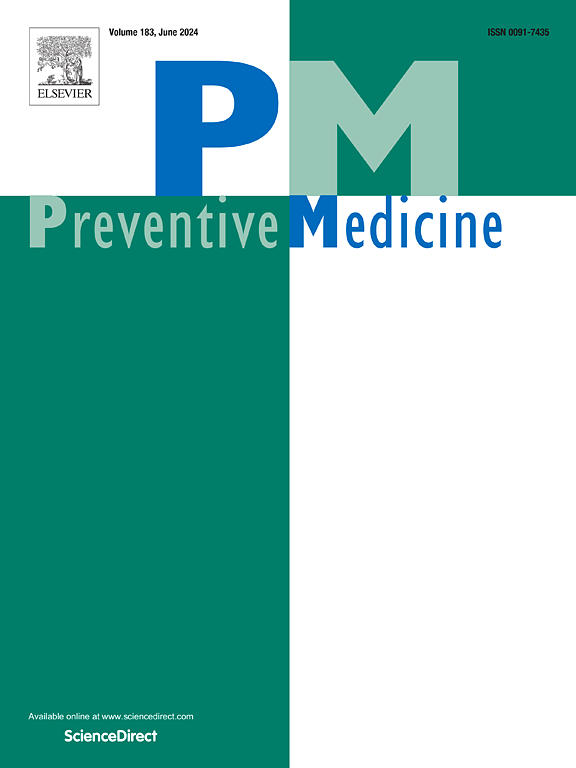建筑与自然环境、空气污染、噪音和痴呆之间的纵向关系:来自两项英国队列研究的结果
IF 3.2
2区 医学
Q1 MEDICINE, GENERAL & INTERNAL
引用次数: 0
摘要
目的最近的流行病学研究调查了痴呆症的各种环境危险因素。然而,大多数现有的研究都集中在单一的环境因素上,并报告了混合的结果。本研究的目的是研究多种环境因素之间的相互关系及其与晚年认知健康的联合关联。方法:本研究基于认知功能和老龄化研究II和威尔士,两项基于人群的队列研究,涉及英国5个城市和农村地区的11055名年龄≥65岁的人。利用地理空间数据,为参与者生成了广泛的环境变量,并通过潜在方法整合到五个领域,包括建筑环境、自然环境、噪音、空气污染和剥夺。使用多状态模型来调查他们与痴呆和死亡的纵向关联,调整了个人社会人口因素。结果建筑环境联合关联的效应量(HR: 1.00;95% CI: 0.66, 1.52),自然环境(HR: 0.95;95% CI: 0.66, 1.36),空气污染(HR: 0.91;95% CI: 0.78, 1.07),剥夺(HR: 1.02;95% CI: 0.96, 1.09)和痴呆发生率一般较小。最强的关联是在噪音中发现的,高水平的噪音暴露与痴呆症发生风险增加相关(HR: 1.22;95% ci: 0.97, 1.54)。然而,置信区间很宽。结论多种环境因素与痴呆发生的联合关系不大。鉴于这一领域的结果好坏参半,未来的研究应解决方法学上的挑战,并加强对痴呆症危险因素的人群水平干预的证据。本文章由计算机程序翻译,如有差异,请以英文原文为准。
The longitudinal relationships between the built and natural environment, air pollution, noise and dementia: results from two UK-based cohort studies
Objective
Recent epidemiological studies have investigated a variety of environmental risk factors for dementia. However, most existing studies have focused on single environmental factors and reported mixed results. The aim of this study is to examine the interrelationships between multiple environment factors and their joint associations with cognitive health in later life.
Methods
This study was based on the Cognitive Function and Ageing Study II and Wales, two population-based cohort studies of 11,055 people aged ≥65 across five urban and rural areas in the UK. Using geospatial data, a wide range of environmental variables were generated for the participants and integrated into five domains through a latent approach, including the built environment, natural environment, noise, air pollution and deprivation. Multistate modelling was used to investigate their longitudinal associations with dementia and death adjusting for individual sociodemographic factors.
Results
The effect sizes of joint associations between the built environment (HR: 1.00; 95 %CI: 0.66, 1.52), natural environment (HR: 0.95; 95 %CI: 0.66, 1.36), air pollution (HR: 0.91; 95 %CI: 0.78, 1.07), deprivation (HR: 1.02; 95 %CI: 0.96, 1.09) and incident dementia were generally small. The strongest association was found in noise, where a high level of exposure was associated with an increased risk of incident dementia (HR: 1.22; 95 %CI: 0.97, 1.54). However, the confidence intervals were wide.
Conclusions
The joint associations between multiple environmental factors and incident dementia were found to be modest. Given mixed results in this field, future research should address methodological challenges and enhance evidence for population-level interventions on dementia risk factors.
求助全文
通过发布文献求助,成功后即可免费获取论文全文。
去求助
来源期刊

Preventive medicine
医学-公共卫生、环境卫生与职业卫生
CiteScore
7.70
自引率
3.90%
发文量
0
审稿时长
42 days
期刊介绍:
Founded in 1972 by Ernst Wynder, Preventive Medicine is an international scholarly journal that provides prompt publication of original articles on the science and practice of disease prevention, health promotion, and public health policymaking. Preventive Medicine aims to reward innovation. It will favor insightful observational studies, thoughtful explorations of health data, unsuspected new angles for existing hypotheses, robust randomized controlled trials, and impartial systematic reviews. Preventive Medicine''s ultimate goal is to publish research that will have an impact on the work of practitioners of disease prevention and health promotion, as well as of related disciplines.
 求助内容:
求助内容: 应助结果提醒方式:
应助结果提醒方式:


